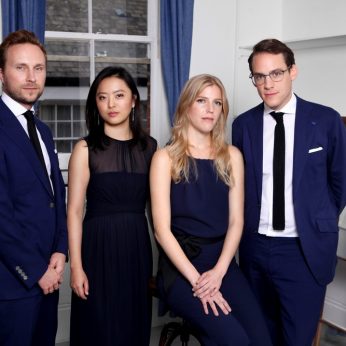Composer: Béla Bartók (b. 1881 - d. 1945)
Performance date: 26/06/2022
Venue: Bantry House
Composition Year: 1909
Duration: 00:35:20
Recording Engineer: Eduardo Prado, Ergodos
Instrumentation: 2vn, va, vc
Instrumentation Category:String Quartet
Artists:
Doric String Quartet (Alex Redington, Ying Xue [violins], Hélène Clément [viola], John Myerscough [cello] -
[quartet]

Béla Bartók [1881–1945]
String Quartet No.1 in A minor Op.7 [1908-9]
1. Lento
2. Allegretto
3. Introduzione: Allegro – Allegro vivace
Béla Bartók’s First String Quartet, Op.7, was not his first essay in this genre, as four earlier works were withheld from performance. Written in 1909, this piece wrestles with the musical and personal concerns that preoccupied the 27-year-old composer. He was torn between the influences of Austro-German culture – one can hear echoes of Beethoven, Richard Strauss, Reger, even Debussy – and the desire to establish a personal style informed by Hungarian folk music. Personally, too, Bartók was internalising feelings of unrequited love for the violinist Stefi Geyer, for whom he was simultaneously writing a concerto. Bartók’s friend Zoltán Kodály referred to the quartet as the return to life of a man who has reached the shores of nothingness. By ensuring that his melodic ideas often reappear in different guises, Bartók achieves a remarkable integration of form through economy of means, both within and across the quartet’s three movements.
The first movement begins slowly and in downcast mood: a musical portrait of Geyer. Its all-pervading sadness was called a ‘funeral dirge’ by Bartók, as a memorial of his relationship with her. An inner struggle for hope characterises much of the movement, with mounting tensions persisting throughout.
The middle movement follows without a pause and gradually accelerates in tempo. Although governed by sonata form, the central movement’s impassioned writing has long been savoured by musicians. After unison and waltz inspired passages, a rustic tone and playful mood interject momentarily before earlier melodies reappear, presented in varied forms.
Hungarian folk music motifs appear in the vibrant closing movement. A slow introduction alternates initially with passages of forceful declamation. The main theme, presented at a faster tempo, is heard against repeated notes in the violins, themselves derived from material in the preceding movement and the opening movement’s syncopation. The musical ideas are developed until a slow section interjects; thereafter, Bartók rebuilds the energy and intensity as the quartet strides to an abrupt conclusion that includes thrilling fifths, major and minor modes in addition to whole-tone and pentatonic scales. By the time the quartet’s ending had been scored, Bartók had found his personal voice.
© Evan Dickerson
Copyright © 2025 West Cork Music. All rights reserved.
Designed and developed by Matrix Internet